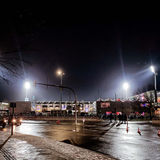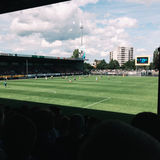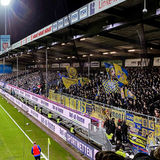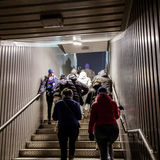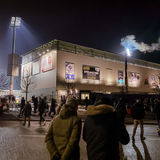
HOLSTEIN KIEL

NOVEMBER 2025
Founded: Oct 7, 1900
Club Members: 11,000
Nickname: Die Störche
Coach: Marcel Rapp
Captain: Steven Skrzybski
German Champions / Bundesliga: 1
Regionalliga Nord: 1
Landespokal Schleswig Holstein Winner: 13
Northern German Cup: 3
Website: www.holstein-kiel.de
Formed after a merger in 1917 between two long forgotten local clubs - Kieler Fußball-Verein von 1900 and Kieler Fußball-Club Holstein von 1902; in accordance with German tradition, Kieler Sportvereinigung Holstein; or Holstein Kiel as they're more commonly known, took the older merging club's year of foundation (1900) as its own. This means that despite the union taking place five years later, 'German Champions 1912' makes it onto the club's honours board on account of Kieler Fußball-Club Holstein von 1902's 1-0 victory over Karlsruher FV in the final that year. The 'new' club actually enjoyed some success of its own in the German Championship with several strong performances in the 1920s including a losing semi-final appearance against SpVgg Greuther Fürth in 1926, before reaching the final in 1930 where they lost out by the odd goal in nine against Hertha Berlin. The following year, Die Störche (The Storks) made the semi-finals again before going down 2-0 to TSV 1860 München.
After the Nazi rise to power, football was restructured in Germany with the creation of the Gauliga in 1933 which funnelled clubs into 16 (later to become 18 following the 1938 Anschluss) regional divisions and Kiel played in the Gauliga Nordmark, achieving consistent top-five finishes although the title eluded them. In 1942 however, another restructure saw the division split into two new leagues and, largely because local big-guns Hamburger SV were placed instead in the Gauliga Hamburg, life became a lot easier for Kiel and they were able to help themselves to a hat-trick of Gauliga Schleswig-Holstein titles during the war years. The title victories earned the club entry into the national championship and they advanced as far as the semi-finals in 1943 where they lost out to eventual winners Dresdner SC, before claiming third place that year with victory over Austrian club First Vienna FC.
Since the war however, success has been more modest with the club primarily spending their time in the second and third tiers of German football although they slipped as low as the fourth tier Oberliga Nord as recently as 2007. Things have improved over the past decade though as they beat FC Energie Cottbus, MSV Duisburg and 1.FSV Mainz 05 to reach the quarter-finals of the DFB-Pokal in 2012 before being turned over 0-4 by a much stronger Borussia Dortmund side. They also ended a 36 year absence from the second-tier by winning promotion from the 3.Liga in 2017 and came within a play-off match against VfL Wolfsburg of becoming a Bundesliga club for the first time just a season later.
Their name may not be a familiar one to football fans outside Germany but after coming agonisingly close to promotion from Bundesliga.2 in 2021 (losing the play-off to 1.FC Köln) and sensationally dumping a near full-strength Bayern München out of the DFB-Pokal that year, this small club on the Baltic coast made history in 2024 by securing (albeit only for a season) promotion to the top-flight for the first time in their history.


GROUND DETAILS
Ground Name: Holstein Stadion
Year Opened: 1911
Renovations: 1922, 1927, 1943, 1949 - 50, 1957, 2006 - 09, 2018 - 2019
Capacity: 15,034 (9,225 standing)
Record Attendance: 31,342 (1951)
Media Seats: 65
Wheelchair Spaces: 55
Undersoil Heating: Yes
Running Track: No
Floodlights: 1,200 lux
Playing Surface: Natural Grass
Pitch Size: 104m x 68m
Grounds:
Holstein Platz (1911 - 1965)
Holstein Stadion (1965 - ) *
* Stadium Renamed

One of the oldest grounds in Germany, Holstein Stadion was opened as Holstein-Platz on 15th October 1911 with a friendly between FV Holstein and Preußen Berlin. Back then the ground was merely a field with a wooden stand, but work over the next few decades gradually saw the capacity reach 18,000 by World War 2.
The ground was badly damaged during the war years and the lack of materials, manpower and money to carry out repairs meant that it wasn't until 1950 that football was once again played at the stadium. Apart from the installation of floodlights in 1957 and the re-naming of the stadium to the Holstein Stadion in 1965, the stadium was generally allowed to fall into disrepair as Kiel played in the lower levels of German football. The poor condition of the stadium reached such a level that in 2005 the DFB (German FA) stepped in and threatened to revoke the stadium licence unless extensive refurbishment of the ground was carried out. This kicked the club into taking action and along with the Kiel city government carried out a €1.6 million programme of works which saw the dangerously unstable terracing replaced by new covered steel tubular stands along the north and west sides of the ground.
Although the 70 year old original main stand remains, work to expand the Holstein Stadion continues and in 2018 plans were announced to replace the previously open crescent-shaped terrace at the east end of the ground with a new 4,500 capacity stand. The original budget was €9.4 million, however construction issues meant that the club turned to 'Plan B' in 2019 and erected a cheaper, albeit temporary, two-tier stand costing €4 million. Although the solution isn't perfect it at least gives Kiel time to fund the long-term vision and, because the stadium's capacity now meets Bundesliga criteria, any promotion to the top-flight would be secure.
Kiel's home end is the 3,300 capacity fully terraced West Stand (Blocks H and I), and since 2018-19, the guest block has been located in the North Stand (Block L - standing, Block K3 - seating).
BUYING TICKETS
Ticket Office:
Website: www.holstein-kiel.de
Telephone: +49 (0) 180 6570029
Email: tickets@holstein-kiel.de

Average Attendance:
2024-2025: 14,893 (Bundesliga)
2023-2024: 13,868 (Bundesliga.2)
2022-2023: 12,312 (Bundesliga.2)
2021-2022: 7,519 (Bundesliga.2) *
2020-2021: N/A *
* Season affected by COVID pandemic
Expected Ticket Availability
The club website and online ticket shop are both in German only but fortunately for non-German speakers, Google Chrome’s translation feature makes booking tickets a very straightforward process. Through the club's ticketing partner Eventim you can have your tickets sent to your smartphone as a Mobile Ticket or made available as a Print@Home option. Tickets can also be posted within Germany (up to 6 days before a match) or left at the box office for you to collect on a matchday.
Actual match tickets can be bought by visiting the fan shops (see Fan Shops, Museum & Stadium Tours section) or the ticket windows at the stadium. In spite of the recent expansion and the fact that Kiel's tenure in the Bundesliga was short-lived, the ground isn't the biggest and you may struggle to get tickets for some matches. Don't be tempted to turn to Viagogo though - Holstein Kiel make a very specific point on their website about refusing entry to anyone in possession of a ticket sourced through this third-party site.
Roughly speaking, for adults, tickets range from €30-€50 for seats, and you can stand on the terraces from €15-€16. Tickets are €2 more expensive if bought from the stadium box offices on a matchday.
Family tickets in the Familienblock (Block U) are also available from the stadium fan shop or via the online ticket shop. It's €43 (1 adult, 1 child), €51 (1 adults, 2 children), €78 (2 adults, 1 child) or €86 (2 adults, 2 children). Discounts are available for children (7-13 years old), students, senior citizens, club members, the unemployed etc and fans under the age of 7 are let in free of charge although they're not allowed on the West terrace (Blocks H and I).
Advance tickets for people with disabilities can also be obtained for €12 (inc. accompanying person) - although tickets are limited and Kiel ask that you register your interest by sending an email to tickets@holstein-kiel.de at least three days before a match.
Information about visiting the Holstein Stadion for fans with disabilities can be found at:
www.bundesliga-reisefuehrer.de
GETTING THERE & AWAY
Stadium Address:
Westring 501,
24106 Kiel


BY CAR:
If you're driving, follow the A7 autobahn from Hamburg and then pick up the A215 towards Kiel itself. As you approach the city take the B76 / Eckernförde / Olympiazentrum exit and then follow Eckernförde / Wik / Universität. When you reach the traffic lights, turn left and you should be able to see the stadium. There's little to no parking available at the ground itself so the club recommends parking at the Nikola Tesla Car Park (P1, Fraunhoferstraße, Kiel - €5 per vehicle) or the RBZ multi-storey (Westring 444, Kiel - €5 per vehicle). Further information about official parking options can be found on the Storks' website here.
PUBLIC TRANSPORT:
Public transport (including ferries) is included in the cost of your match ticket anywhere within the Schleswig-Holstein Transport Area (NAH.SH) on the day of the match until 6am the following morning if you want to stay out celebrating another Drei Punkte (3 points) for the "Storks". On a matchday, a special bus service (line X91) runs from the Hauptbahnhof (bus stop C3) to the 'Westring Höhe' stop a short walk to the stadium every 15 minutes. The service also stops at 'Wilhelmplatz' and 'Kronshagener Weg' and runs for two hours either side of the match. Alternatively, Buses 11 (Direction: Wik Kanal), 12 and 13 (Direction: both Schilksee/Strande) also leave from the Hauptbahnhof and will drop you off at 'Hanssenstraße' which is a ten-minute walk to the stadium.
WALKING DIRECTIONS:
The Holstein Stadion is about three miles from the centre of Kiel, so unless you have plenty of time on your hands then catching a bus is a better option.
If you fancy the walk though, come out of the Hauptbahnhof onto Ringstraße and keep following it as it crosses Schutzenwall. The road goes through a number of name changes to keep you on your toes, becoming Herman Weigmann Straße, crosses Kronshagener Weg (you can wait for the X91 Shuttle Bus here if you've decided walking was a bad idea), becomes Stephan Heinzel Straße and then finally Eckernförder Straße. Follow this until you reach Westring, turn right and keep following it for about two miles until the stadium appears right in front of you.
If you make it, well done ! But trust us, taking the bus is the better option.
FAN SHOP, MUSEUM & STADIUM TOURS

FAN SHOP:
There's a small fan shop in front of the main stand (Westring 501, 24106 Kiel; Tel: +49 (0) 431 31840040; email: fanshop@holstein-kiel.de; open 12pm-6pm, Mon, Weds & Fri; 2 hours before kick-off until one hour after full-time on matchdays - entry on a matchday is restricted to those with a valid match ticket only).
A mobile fan shop also sets up outside the ground on a matchday.
Information about additional fan shops in the Kiel area can be found here.
FOOD & DRINK OPTIONS
The usual fast food options (chips, bratwurst etc) are sold in the stadium and you can pay for everything with cash or contactless payment using your debit or credit card, smartphones via Apple Pay, Google Pay etc.
For pre-match food and drink, the locals head to the Kieler Brauerei (www.kieler-brauerei.de) in the old town. Close to the ground, there's the Alter Schwede restaurant on Holtenauer Straße, and then there's Pogue Mahone (www.poguemahone.de), which you've probably guessed, is an Irish pub on Bergstraße in the city centre.
STORAGE OF BACKPACKS & BAGS
You can take bags into the stadium after a quick once over from security but anything larger than an A4 sheet of paper (i.e backpacks, large bags) will have to be stored in the fan shop at the stadium. The drop-off point opens two hours before kick-off and you can collect your gear up to an hour after the full-time whistle has been blown. If you miss this deadline then the folks in the fanshop will look after it for a couple of weeks before it's forwarded to the lost property office in the centre of Kiel (Fabrikstraße 8-10, 24103 Kiel).
OTHER CLUBS IN THE AREA
BUNDESLIGA: FC St. Pauli, Hamburger SV
3.LIGA: FC Hansa Rostock


